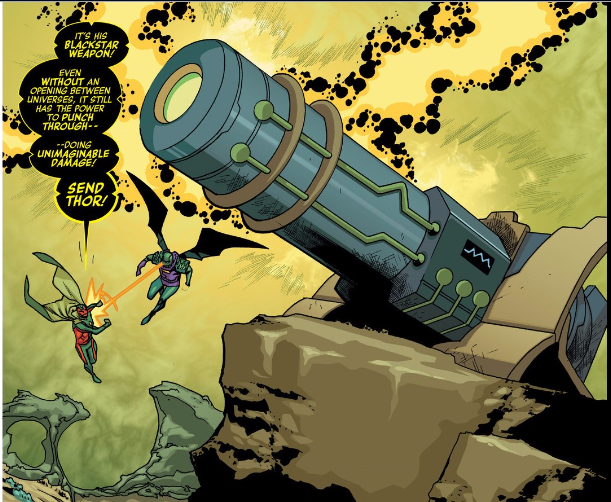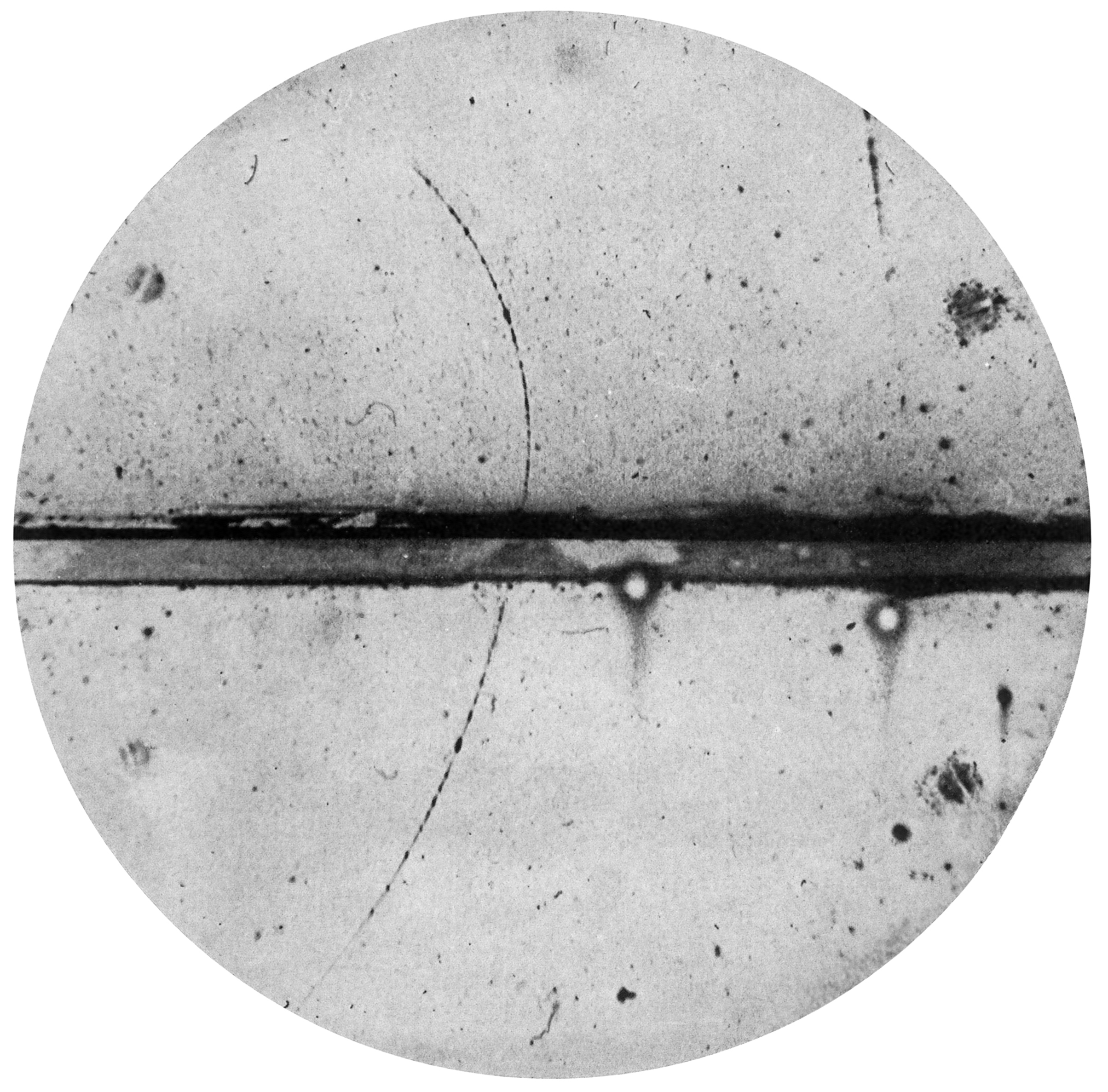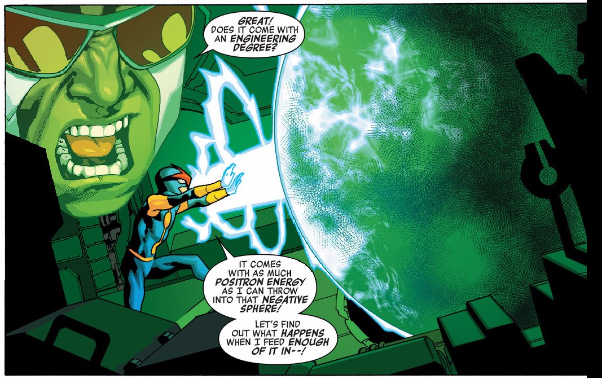 The Avengers found themselves in the Negative Zone. Positron time, right?
The Avengers found themselves in the Negative Zone. Positron time, right?
Right. Well…yeah, we’ll go with right.
But what is positron action, let alone what’s a positron? That’s just a made-up science-fiction term, isn’t it? After all, Isaac Asimov gave all of his robots “positronic brains” in his novels – so Asimov created the term, right?
Nope.
Quick setup – in All-New All-Different Avengers #12 (available at your local comics shop or at Comixology), the third part of the Negative Zone storyline, the All-New, All-Different Avengers escaped from the Negative Zone and found themselves back on the desolate planet on which they crash-landed two issues earlier. Quick background – Marvel’s Negative Zone was discovered by Reed Richards, and is another dimension where all matter is negatively charged, rather than…positively charged(*). The Negative Zone has been visited many times, and invaders from it have made their way to earth on many occasions as well. Most often leading the forces of the Negative Zone is Annihilus a creepy armor-wearing bug thing, who is in fact opposing the Avengers in this storyline. Annihilus has been to the Marvel Universe proper many times and seeks to claim it as his own.
Blending the world of fiction and fact a little (to make it easier for storytelling) the Negative Zone has its own physics and unique characteristics. For example, the entire dimension is filled with a breathable atmosphere at the same pressure as earth. Most energies seem to work the same there (with some exceptions), and overall, mechanics seem to work the same in the Negative Zone as they do on earth.
The Negative Zone’s “negative charge” (relative to the Marvel Universe’s presumed positive charge) means roughly that what is positive here is negative there, and…well…the science of the actual Negative Zone is a little weird and more often than not, fits the needs of the story being told in the Negative Zone. But – that said, if you called it an antimatter universe, you wouldn’t be too far from…some kind of truth.
Okay – let’s science things up a little here.
Antimatter is the opposite of matter that we’re the most familiar with. It’s material that’s composed of antiparticles – particles with the same mass as those we are familiar with, but have an opposite charge – as well as some other characteristics. As particle physicists and Star Trek fans know, when antimatter meets matter, they annihilate each other, releasing gamma rays, neutrinos and matter-antimatter particle pairs with a lower mass than their parents. Antimatter particles can join together to form antimatter elements, such as antihydrogen and antihelium, although both are fleetingly rare in our universe.
antihelium, although both are fleetingly rare in our universe.
What does this have to do with the story in Avengers #12, and what’s a positron?
Annihilus’ plan in the storyline was to use his Blackstar Weapon to rip open a hole between the Negative Zone and the Marvel Universe, allowing him to once again invade and have another go at conquering his next-door neighbor universe. The Avengers take turns pounding on Annihilus and the weapon in some well-orchestrated teamwork, with Nova finally jumping in and blasting the weapon’s negative sphere with positron energy.
And there we are – positrons. Was Nova (and by extension, the issue’s writer, Mark Waid) just using a cool science fiction word?
Nope – a positron is an antimatter electron. Belonging to the group of particles called leptons, a positron is simply an electron with a positive charge. If you remember chemistry, electrons have virtually no mass for most intents and purposes, so a simplistic way to think about a positron is that it’s a naked positive charge while an electron is a naked negative charge. Positrons are fairly common – which is to say you can find them if you know where to look, not that there’s a pile under your couch – and are often associated with beta radiation, when a neutron in an atomic nucleus collapses and either an electron or positron is released. The positron is the antiparticle of the electron.

Anderson’s picture of a positron’s path. It passed through a lead plate (center) and curved to the left, indicating it had a + charge
Positrons were theorized by physicist Paul Dirac in 1928 while he was working to develop a version of quantum mechanics that incorporated special relativity, and actually discovered in 1932 by Carl Anderson in a cloud chamber experiment. Going back to the Asimov call out at the start, as best anyone can tell, Asimov used the term “positronic brain” because when he was writing his stories in 1939-40, the positron had just been discovered, and Asimov was nothing if not hip on the latest developments in science. Uses of “positronic brains” in androids or robots since, from the Avengers’ Vision to Star Trek’s Data all are nods back to Asimov’s use of the term.
Back to Avengers #12, what would Nova hope to accomplish by projecting, presumably, a blast of positrons at a sphere of negative energy (we’re safely going with the idea that those are electrons in there)? Well, the Blackstar Weapon explodes when he does it, so there was that. But why?
 When matter and antimatter meet, they annihilate one another and release gamma rays, among other stuff, remember? (A quick shout out to Avengers #12’s color artist, Dave McCaig, which made the resultant explosion greenish. In the Marvel world remember, gamma rays = green. Thanks, Hulk.)
When matter and antimatter meet, they annihilate one another and release gamma rays, among other stuff, remember? (A quick shout out to Avengers #12’s color artist, Dave McCaig, which made the resultant explosion greenish. In the Marvel world remember, gamma rays = green. Thanks, Hulk.)
But positrons aren’t just used in science fiction when heroes need to annihilate weapons capable of ripping holes between universes.
Positron-emission tomography (PET) is a method that’s used to map the brain and brain activity, using positron-electron annihilation. When a person undergoes a PET scan, they’re injected with a glucose solution that contains a radioactive substance (such as oxygen-15, fluorine-18, carbon-11 and nitrogen-13) which undergoes positron emission via beta decay. When the positron is released by the radioactive nucleus, it eventually meets an electron in the brain tissue and annihilation occurs, releasing two gamma ray photons. The gamma rays that are given off by the annihilation are recorded, allowing a computer to create a map of the brain showing where the glucose accumulated.
PET scans can be used to map brain activity – active regions of the brain use more glucose than less active regions; as well as help indicate a wide variety of brain disorders, including Alzheimer’s.

Brain activity while performing different activities, as visualized by a PET scan. Red indicates areas of high activity.
But what’s going on inside the brain during a PET scan – think of it as what Nova’s doing on a much smaller scale. A positron meets an electron, and…annihilation. Gamma rays are released. And no one turns into the Hulk.
Positron – positively charged electron that annihilates electrons when it meets them. Now go impress people.
(* Okay, okay – yeah, Negative Zone physics are a weird collection of rules. Heck, even in this issue, when Thor’s hammer fails to make a scratch on the Blackstar Weapon, the Vision offers up “Negative Zone physics –!” as an excuse. If the Negative Zone was truly antimatter – its particles all had charges opposite to the charges of the particles in the Marvel Universe, it would lead to annihilation when a traveler went from one universe to the other, and “Annihilation” was the overarching name of an acclaimed 2006 Marvel crossover event chronicling what happened when Annihilus invaded the Marvel Universe. But in that and his other forays into the Marvel Universe, Annihilus acts more like Genghis Khan than an event of actual annihilation resulting from matter touching antimatter. There are lots of theories and stories about the Negative Zone, but we’re just trying to explain what positrons are here. Safe to say, if you’re in the Marvel Universe and can come up with a theory that explains the phenomena seen in the Negative Zone and in interactions between the Marvel Universe and the Negative Zone, there’s a prize waiting for you in Marvel Universe Oslo, Norway.)
Did we miss something about the Negative Zone, do you have a theory about how matter and antimatter work in the Negative Zone, or are you worried about the same reaction that powers the U.S.S. Enterprise’s warp nacelles can happen inside your brain? Come on over to our Facebook page, and we’ll all speculate together!






